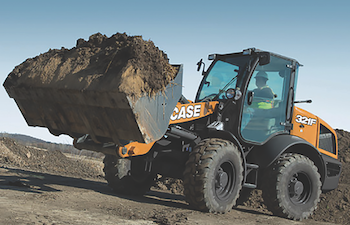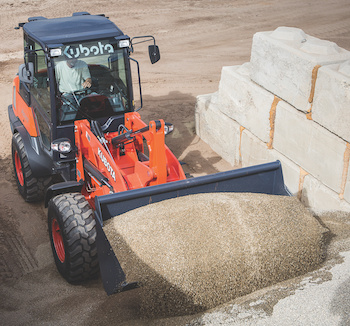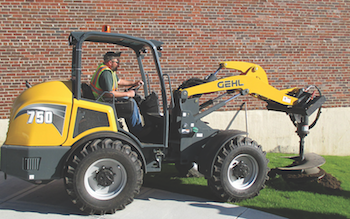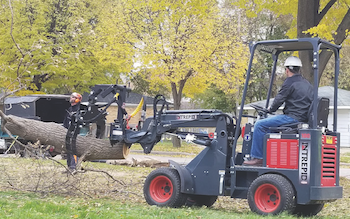Industry outlook: compact wheel loaders
Alternative to compact track and skid-steer loaders
Compact wheel loaders are trending toward being as versatile as compact track and skid-steer loaders. Higher and greater lift capacities combined with user-friendly controls and in some cases, lower purchase prices, make them a go-to tool for rental center customers.
 |
| Parallel linkages in wheel loader lift arm design allows units to raise and lower loads relatively evenly, simplifying operation. |
 |
| Operators sit higher on a compact wheel loader, which gives better visibility when compared with compact track loaders and skid-steer loaders. |
 |
| Most compact wheel loader models feature a quick-attach mount for attachments that can also be used on compact track or skid-steer loaders. |
 |
|
The smallest compact wheel loaders typically rent for $2,000 per month or less, while larger, mid-sized models rent out for between $2,500 and $3,000 per month. Miniloader.com sources report that electric compact wheel loaders will soon be introduced. |
We asked leading compact wheel loader experts about where they see compact wheel loaders trending and fitting in to rental centers’ fleets.
Contractors curious about compact wheel loader capabilities
Andrew Dargatz, Brand Marketing Manager, Case Construction Equipment
Compact wheel loaders are trending in a positive direction due to increased interest in greater reach, more breakout force, heavier tipping loads and greater overall visibility than other compact options.
While skid steers and compact track loaders get quite a bit of attention in the rental market – and rightfully so – compact wheel loaders are gaining a foothold in the United States, and the rental market is one of the top industries driving that success, and it’s growing year over year. Manufacturers are beginning to come out with features and functionality designed specifically for the rental market that meet user demands for an improved operator environment, comfort and control.
The key to ROI for any piece of equipment in a rental fleet is utilization. It’s important to remember that the compact wheel loader’s coupler is the same as most common couplers for skid steers and compact track loaders, and therefore can run many of the same attachments. That ability to diversify its use beyond just a loader bucket makes it easier to rent more often and will ultimately make it more profitable — the more hours you can rent it, the lower its total cost of ownership.
Rental centers should keep seasonality in mind when it comes to compact wheel loaders. One of the areas where we’re seeing the most traction with compact wheel loaders is in the snow removal market, and many of those machines are rented depending on the size of the operation and the region. Having that compact wheel loader in your fleet and being able to pair it with a sectional snow pusher or other snow removal apparatus now becomes an asset that is rentable year-round vs. just during the warm seasons.
Compact wheel loaders are still an emerging product category in the United States. Rental gives contractors who are curious about the product line and its capabilities, and how it straddles that line between skid steers or compact track loaders and wheel loaders, the opportunity to rent and familiarize themselves with the machine before they commit to buying it. It’s a product category with a lot of curiosity around it right now, and that’s a benefit to rental businesses.
Greater demands for versatility
Scott Britton, product applications specialist, Caterpillar
More compact/small-size units being used on construction sites. This allows for more mobility in tighter work spaces. As far as technology goes, we have found that customers seem to prefer technology that doesn’t interrupt their daily operations. Features such as improvements in fuel efficiency without compromising productivity, programmable return-to-dig kickouts that saves on cutting-edge life and aids operator comfort are just a few examples of the new integrated technology that contractors want.
The rental end user generally wants a no-fuss, high-production, short-term solution to complement his or her current fleet. Integrated, behind-the-scenes technology can best benefit that customer. If your rental fleet has some of the latest models with the newest features, it will pay off if they are properly configured. Features, for example, such as speed-sensitive ride control that maintains the load in the bucket offers greater operator comfort. It can pay off with returning rental customers knowing your rental center has premium products available in your fleet.
For the best ROI, rental rates need to be competitive to help both the asset owner and the end user. When purchasing a new loader to place into rental, balancing the available options is key between those of the rental customer versus those of the retail customer or future used resale. Regionally, those options can vary quite a bit.
Compact wheel loaders are being asked to do more every day. That wasn’t necessarily the case of loaders of the past. Land clearing has become a hot market and using wheel loaders in these applications provides a unique perspective on the job site vs. other machines. The height of the wheel loader allows operators to sit above their work. With an articulating hitch, it allows access in areas not normally achieved with a typical mulching machine, all while disturbing the soil less because of its great flotation characteristics.
Consider wheel loaders for high-production jobs
Drew Miller, product marketing manager, compact wheel loaders, John Deere
Construction & Forestry
Improving lift height and attachment capabilities are important trends with compact wheel loaders. There are now more options and offerings that allow the operator to reach new heights with their machines. These offer the ability to stack and place pallets with forks or dump into trucks or mixers that they couldn’t before either with standard buckets or potentially with larger buckets moving lighter materials.
 |
| Drew Miller, product marketing manager, compact wheel loaders, John Deere Construction & Forestry. |
John Deere launched a High Lift configuration in 2017 and later introduced a high-dump bucket, that when paired together, can offer a dump height over 12 feet.
Operators can better manage the compact wheel loader, especially while using attachments. John Deere offers an attachment-assist package with creep control and throttle lock that allows the operator to reduce ground speed and reduce the sensitivity and improve control while also providing full hydraulic flow for attachments such as a snow blower, pickup broom or silage defacer.
These technical advances are opening up more ways to use smaller machines. For the rental segment, a customer who couldn’t or wouldn’t rent a larger loader to get the necessary lift height may now consider a compact wheel loader that can be more easily trailered to the site. John Deere’s newest models are equipped with third-function hydraulics located on the joystick, making it easier to use attachments. The linkage is designed to have minimal rollback to control loads on forks throughout the lift path. These types of features enable a less-experienced operator to be able to focus on the task and less on the machine.
ROI starts with acquisition cost, is fueled by strong utilization and limited maintenance and repair costs and wraps up with disposal. Compact wheel loaders have unique characteristics that can make them a better choice to alternative machines. The acquisition cost is typically more than a skid steer, but with Tier 4 Final technology required with larger skid steers, that gap is smaller. Maintenance costs on wheel loaders may be less than skid steers, thanks to reduced tire wear, superior visibility and less damage. Resale is potentially superior on wheel loaders because they handle a higher duty cycle that translates to higher hours and a longer life.
The key to making the ROI work on loaders is the utilization. They are a less common rental fleets than skid steers, but there are applications where a wheel loader will shine. If a rental center has a local customer base that values the loader’s benefits of mobility, visibility, superior entry and egress, then they could realize a positive ROI by adding a rental spec compact wheel loader like the John Deere 204L to their fleets.
Underground contractors, utility contractors, concrete contractors, landscapers, institutions and municipalities are particularly attracted to the capabilities of compact wheel loaders. They work well in production environments, high-hour applications and where the operator is in and out of the machine. In cold-weather locations, rental centers report compact wheel loaders are popular for winter snow rental contracts. Units used for that are typically spec’d with a cab and equipped with a snow pusher.
Wheel loaders offer better visibility
Jeff Jacobsmeyer, product manager/excavators, wheel loaders and tractor loader backhoes, Kubota
 |
| Jeff Jacobsmeyer, product manager/excavators, wheel loaders and tractor loader backhoes, Kubota. |
Compatibility of front attachments is very popular with today’s new compact wheel loaders. Many of the same attachments for compact track loaders and skid-steer loaders can be shared if the wheel loader is equipped with a skid-steer style of coupler.
Operators enjoy the benefit of sitting higher on a compact wheel loader, which gives better visibility when compared with compact track loaders and skid steer loaders. In many cases, the front coupler is compatible with compact track loaders and skid steers, however, the operators need to make sure the recommended operating capacities are not exceeded.
Wheel loader rentals have become popular in the winter months for snow removal companies that do not want the overhead of owning machines during the summer when they are most likely not producing revenue. Acquiring new late-model machines every year reduces the chances of downtime when they are needed for winter cleanup. As the compact wheel loaders come off winter snow rental, they can then be remarketed in the spring to other customers.
Options best match machine to job
Brian Rabe, regional training manager, Manitou North America
Operator comfort and application-focused features are trending in the compact wheel loader market. Two examples of this, offered as options on Gehl articulated loaders, are the three-speed drive system and Hydraglide ride-control system. These options allow
 |
| Brian Rabe, regional training manager, Manitou North America |
operators to smoothly transport materials over great distances at high speed. The Hydraglide system allows the lift arm to move and absorb bumps during transport, improving operator comfort while reducing material loss. The three-speed drive system allows for speeds up to 19 mph so the operator can be more efficient and get the job done faster.
The best way to take advantage of Gehl’s value-generating features in the articulated loader range is by fully understanding what the benefits and features are and which of the features excel in certain applications. Approaching the customer from an application standpoint allows a knowledgeable sales associate and end user to match the machine to the application. For example, the Constant Speed Operation option acts as a type of cruise control for machine travel speed and auxiliary hydraulic flow rate, giving the operator the ability to lock in a travel speed and broom/snowblower rotation speed so the operator can better focus on driving the machine.
Electric models coming on the market
Chris Leurink, general manager, Miniloaders.com
One of the newest developments that absolutely stands out is the introduction of 100 percent electrically driven wheel loaders. These machines have been introduced by established European manufacturers and are not available yet in the United States, but expect these machines to show up at U.S. trade shows soon. The Wacker Neuson WL20E, weighing 5,000 pounds and the Belgian Knikmops 130E, weighing 4,000 pounds, can typically be used intensively for two hours on a fully charged battery, depending on the application.
 |
| Chris Sleurink, general manager, Miniloaders.com |
Telematics is also making inroads in compact wheel loaders. It allows equipment/fleet owners to receive and monitor machine data such as consumption and productivity, but also the whereabouts of the machine. Most small wheel loader manufacturers offer GPS tracking options.
Wheel loader brands offer many different machine options. Rental houses and end-users should look closely at options that improve user friendliness and machine versatility. Rental centers must realize that a compact wheel loader may be used for anything, so ask your dealer to equip it as such. Look at the auxiliary hydraulics configuration and operation. Many brands now offer a specialized joystick that controls all hydraulic boom functions.
With purchase prices ranging from $30,000 to $100,000 in the 25- to 75-horsepower compact wheel loader range, it is difficult to provide an exact ROI. The smallest compact wheel loaders typically rent for $2,000 per month or less, while larger, mid-sized models rent out for between $2,500 and $3,000 per month. Final ROI depends on:
• Long term vs. short term rental periods, with long terms, such as extended snow removal periods, being more profitable. The more long-term rentals, the shorter the pay back.
• Residual value: Compact wheel loaders typically have high residual value if maintained properly. Devaluation is also affected by prior rental applications. Corrosive job site conditions such fertilizer plants will decrease the condition and residual value of rental equipment.
• When compared with skid-steer loaders, maintenance and running costs are less because of less fuel consumption and tire wear.
Compact wheel loaders equipped with cabs, road lighting and enough hydraulic output to operate a snowblower are in demand with landscapers and other contractors. They often have winter snow removal contracts with customers and municipalities because the units can maneuver around obstacles, are fast and more comfortable to drive than skid steer loaders.
However, the fastest growing market for compact wheel loaders is the green industry. Rental houses are wise to recognize this and should anticipate contractors who need an articulating loader that is turf-friendly and versatile.
With the advent of electrically powered loaders, expect inquiries from indoor demolition contractors who will be asking for zero-emission loader equipment to supplement electric concrete breakers, mini excavators and dump carts already available on the market.
Copyright 2019 Urbain Communications, LLC. All rights reserved. Contact curbain@urbaincomm.com for permission to reprint or rebroadcast all or part of this article.










